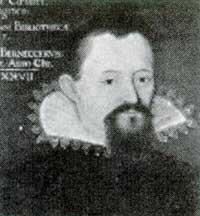Kepler, Johannes
(1571-1630)
This prestigious German astronomer entered Weil der Stadt, Wünttenberg in 1571. In his family there was not much money and since he was young he had to devote himself to many professions. Kepler did not adapt to this situation, as he was a child when smallpox was still about to lose sight. He entered the Adelberg Seminary but soon began studying mathematics at the University of Tübingen, where he learned Kopernik's theories through astronomer Maestlin. Since 1594 he taught mathematics and science at the University of Graz. He received the invitation of Tycho Brahe, who settled in Prague, A year later Brahe died and Kepler held his post as court astronomer. Information on all experiments and observations made by Brah also came to Kepler's hands. This fact undoubtedly had a great influence on Johannes' career.
During these years Kepler studied astronomy from the point of view of mysticism. Pythagoras tried to understand the "music of the spheres" he defined and announced that the notes of the Earth were me, fa and mi. Although it was reported among astronomers that Kepler was made of his head, the court authorities did not snatch his support.

He was the defender of the heliocentric system that Copernicus defined. His most important contribution was to illuminate the movement of the planets around the Sun. With the data collected by Tycho Brah he discovered the laws on the movement of planets. The first two laws were published in 1609 under the title of Astronomy Nova; the first law says that the planets move in elliptical orbits around the Sun, the Sun being in a focus; the second law states that the imaginary line that goes from the planets to the Sun sweeps the same surface into the time unit (and therefore the orbital velocity of the planets increases as it approaches and moves away). The third law, published in 1619 in his book Harmonices mundi libri, stated that the square of the period the planet needs to complete its orbit is proportional to the cube of the average distance to the Sun. The complete explanation of theories about the movement of planets was published in 1627 by Rodolfo (Rodolfo II. in homage to the emperor).
Kepler's fame spread. Galileo gave him a self-designed telescope, but Kepler could not use it because he had almost lost sight. Galileo's gift was used by light waves to analyze the phenomena that occur when crossing the lens. The result of this work is the Dioptrice essay published in 1611 and which, for many, can be considered as the starting point of the current optics.
He dealt with the contribution force that occurs between the planets in the last years of his life, but found no reasonable explanation. However, this task did not remain at all, as Newton's discoveries demonstrated some years later.
However, Kepler did not come to see this demonstration. On the one hand, because he was blind and on the other, because in 1630 he was discovered in Regensburg.
Buletina
Bidali zure helbide elektronikoa eta jaso asteroko buletina zure sarrera-ontzian











